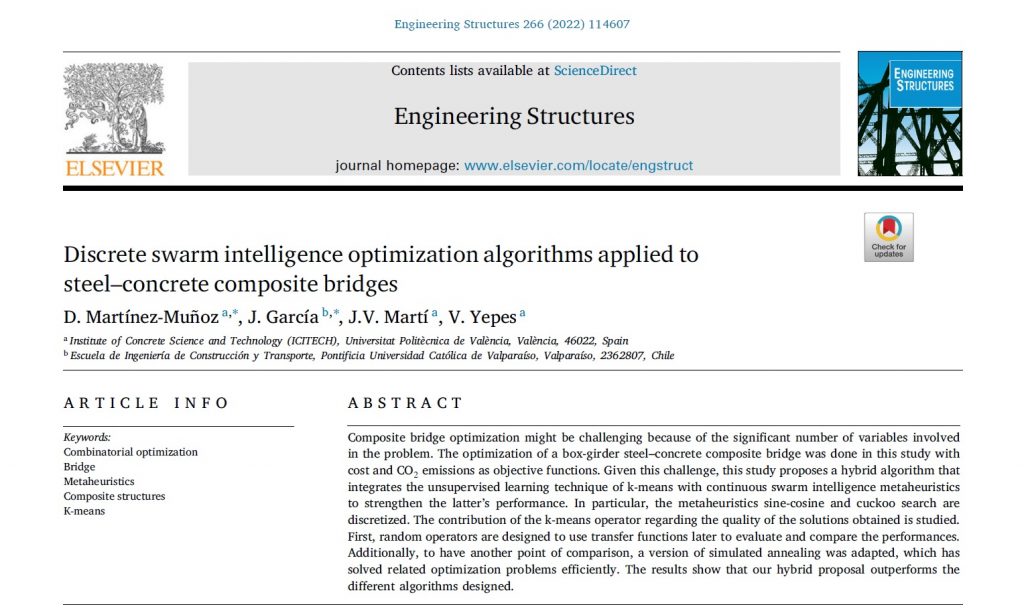 Acaban de publicarnos un artículo en la revista Engineering Structures, revista indexada en el primer cuartil del JCR. En este caso se ha optimizado un puente mixto de hormigón y acero, mediante algoritmos discretos de inteligencia de enjambre. El trabajo se enmarca dentro del proyecto de investigación HYDELIFE que dirijo como investigador principal en la Universitat Politècnica de València.
Acaban de publicarnos un artículo en la revista Engineering Structures, revista indexada en el primer cuartil del JCR. En este caso se ha optimizado un puente mixto de hormigón y acero, mediante algoritmos discretos de inteligencia de enjambre. El trabajo se enmarca dentro del proyecto de investigación HYDELIFE que dirijo como investigador principal en la Universitat Politècnica de València.
El artículo lo puedes descargar GRATUITAMENTE en el siguiente enlace: https://authors.elsevier.com/sd/article/S0141-0296(22)00708-8
La optimización de un puente mixto puede ser un reto debido al importante número de variables que intervienen en el problema. En este estudio se realizó la optimización de un puente mixto de hormigón y acero con vigas en cajón, con el coste y las emisiones como funciones objetivo. Ante este reto, el trabajo propone un algoritmo híbrido que integra la técnica de aprendizaje no supervisado de k-means con la metaheurística de inteligencia de enjambre continuo para reforzar el rendimiento de esta última. En particular, se discretizan las metaheurísticas sine-cosine y cuckoo search. Se estudia la contribución del operador k-means a la calidad de las soluciones obtenidas. En primer lugar, se diseñan operadores aleatorios para utilizar posteriormente funciones de transferencia que permitan evaluar y comparar los rendimientos. Además, para tener otro punto de comparación, se adaptó una versión del recocido simulado, que ha resuelto eficientemente problemas de optimización relacionados. Los resultados muestran que nuestra propuesta híbrida supera a los diferentes algoritmos diseñados.
Highlights
- A cost and CO2 emissions optimization a three-span steel–concrete composite bridge has been performed.
- The optimization considers 35 design variables on average 55 possible choices for each variable.
- The performance and robustness of a hybrid k-means swarm intelligence metaheuristic is studied for this optimization problem.
- Hybrid k-means algorithm results are compared with other discrete trajectory based and swarm algorithms.
Abstract
Composite bridge optimization might be challenging because of the significant number of variables involved in the problem. The optimization of a box-girder steel-concrete composite bridge was done in this study with cost and emissions as objective functions. Given this challenge, this study proposes a hybrid algorithm that integrates the unsupervised learning technique of k-means with continuous swarm intelligence metaheuristics to strengthen the latter’s performance. In particular, the metaheuristics sine-cosine and cuckoo search are discretized. The contribution of the k-means operator regarding the quality of the solutions obtained is studied. First, random operators are designed to use transfer functions later to evaluate and compare the performances. Additionally, a version of simulated annealing was adapted to have another point of comparison, which has solved related optimization problems efficiently. The results show that our hybrid proposal outperforms the different algorithms designed.
Keywords
Combinatorial optimization; Bridge; Metaheuristics; Composite structures; K-means
Reference:
MARTÍNEZ-MUÑOZ, D.; GARCÍA, J.; MARTÍ, J.V.; YEPES, V. (2022). Discrete swarm intelligence optimization algorithms applied to steel-concrete composite bridges. Engineering Structures, 266:114607. DOI:10.1016/j.engstruct.2022.114607
Como este artículo está publicado en abierto, os lo dejo para vuestra descarga:
